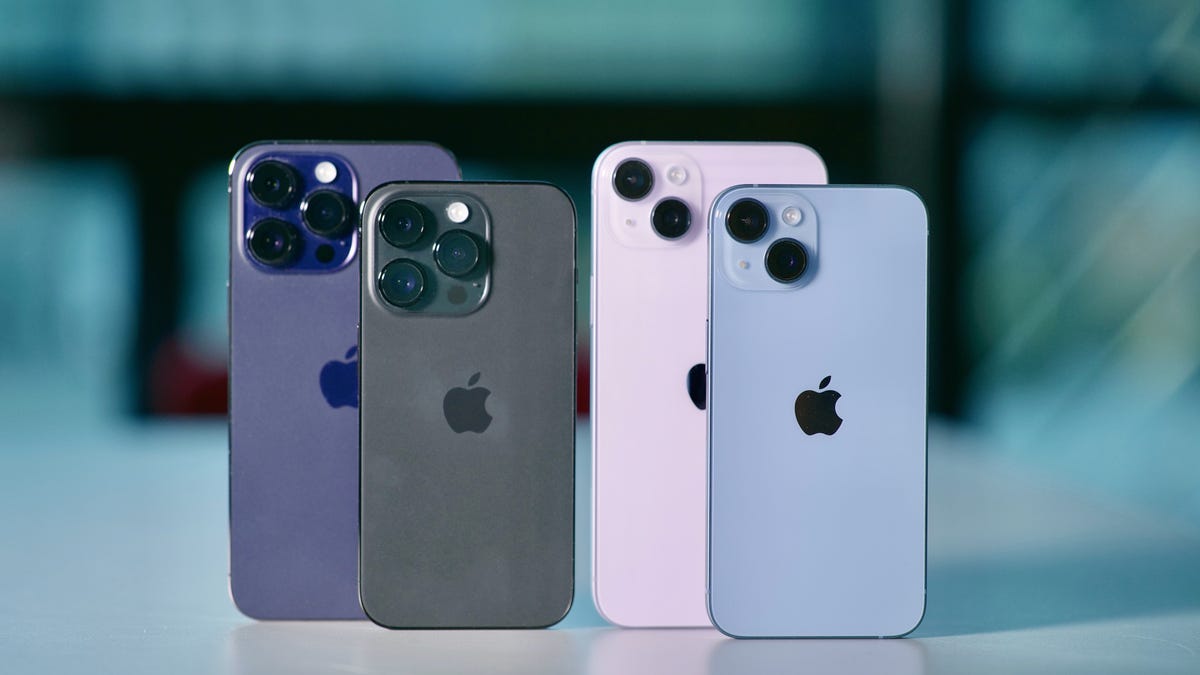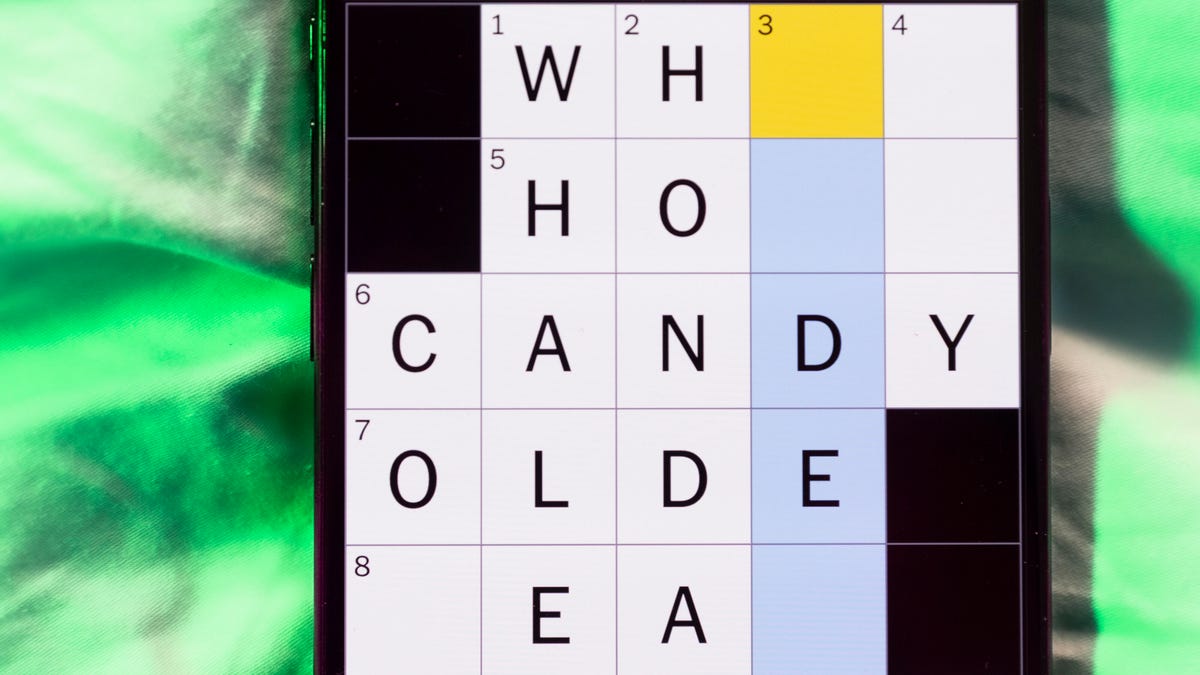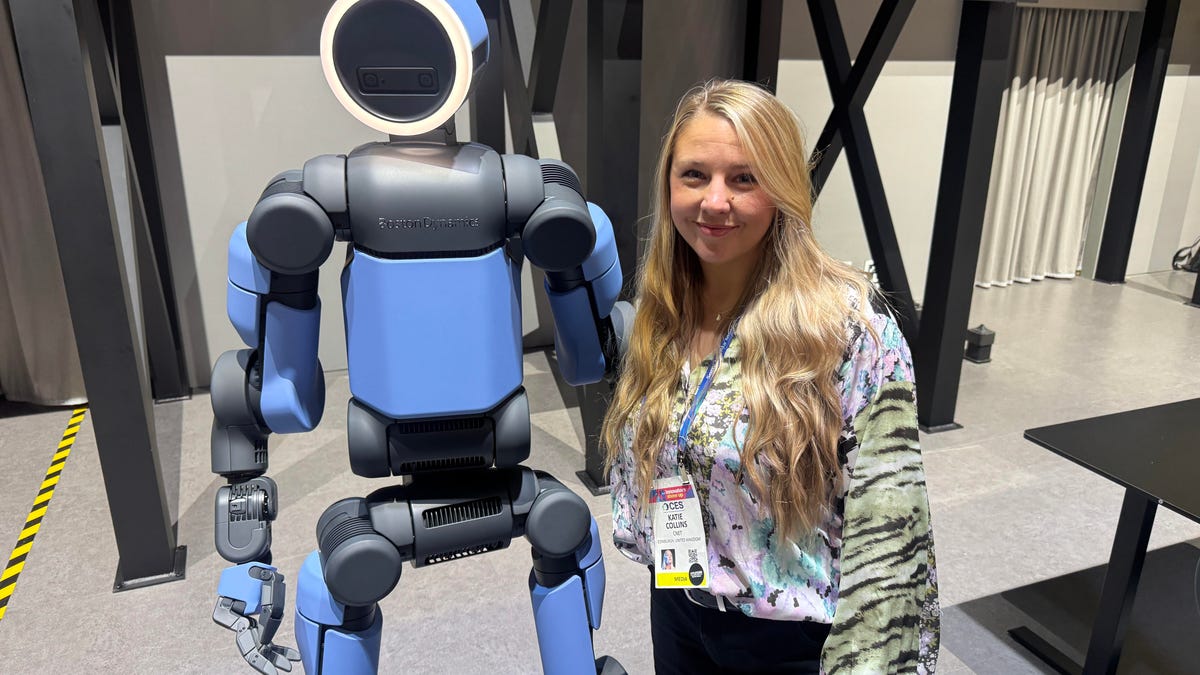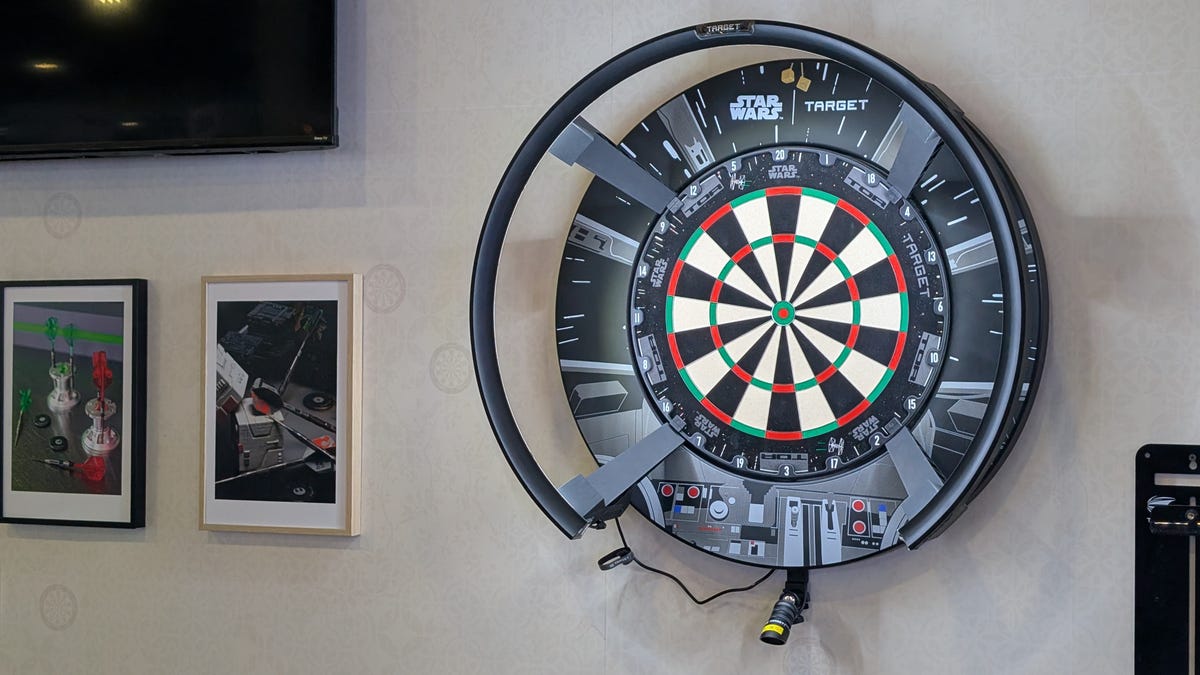Technologies
iPhone 14 and 14 Pro 3 Months Later: Highs and Lows of Apple’s Newest Phones
We ran in-depth tests on the iPhone 14 line’s batteries, cameras and Emergency SOS via Satellite.

In a year packed with numerous phone releases, Apple’s iPhone 14 lineup is curious. There is the iPhone 14 Pro and 14 Pro Max, which represent the pinnacle of the company’s design, software and hardware. The iPhone 14 Pro is notably defined by an oval-shaped screen cut-out for the True Depth camera, which replaces the notch, called the Dynamic Island. But then, there’s the iPhone 14 which seems like a repackaged iPhone 13 Pro without the stainless steel body or the third rear camera for telephoto pictures.
Apple discontinued the iPhone 13 Mini and replaced it with a bigger version of the 14 called the iPhone 14 Plus. Starting at $929, it’s meant to be a slightly «more affordable» way to get a large screen iPhone without crossing that $1,000 line. Taken in total, you have two high-end Pro iPhone models, a big-screen regular iPhone and the standard iPhone 14, which on the surface doesn’t seem like much of an upgrade from the iPhone 13. Apple’s lineup offers exciting new features while also seeming like a curious repeat of what came out last year.
Over the past three months, I used the iPhone 14 as my daily driver and the 14 Pro as my work phone. During that time, I ran in-depth battery tests, took numerous photos, used them to film CNET videos and tried out the new Emergency SOS via Satellite feature. Several of my CNET colleagues have also tested the cameras and compared them to the likes of the Google Pixel 7 Pro and Galaxy S22 Ultra. Here are my thoughts on the iPhone 14 family since my initial reviews back in September.
The iPhone 14’s battery doesn’t last as long as the iPhone 13
I’ve never met a single person who said, «Wow, I get too much battery life on my phone.» But I have definitely met many who have wanted more. A phone’s battery life lands at an interesting crossroads. You have the physical and chemical limits of modern lithium batteries as well as the clever software and processing optimizations that aim to make those batteries more efficient.
Apple doesn’t disclose the size of the batteries in its phones, but I wish it did because they’re relatively small compared to the batteries in Android phones. This isn’t about shaming Apple, but highlighting how much longevity the company ekes out of that battery through software optimizations and the efficiency of its A-series chips. In fact, last year’s iPhone 13 Pro Max lasted longer on a single charge than any other phone we tested.
The same can’t be said for this year. The iPhone 14 series gets good battery life but is definitely a step down from the iPhone 13 family, which gets longer battery life. The difference wasn’t drastic, and I imagine most people aren’t upgrading their phone every year and would never be the wiser.
At CNET, we run a few battery life tests and note how long the phones last in real life. The first test I ran with each phone was an endurance test. For 45 minutes, I played video games (some were online) as well as watched videos, scrolled through social media apps like TikTok and Instagram and made a video call over FaceTime. During that time, the iPhone 14’s battery decreased 10%, the 14 Plus dropped 5%, the 14 Pro lost 8% and the 14 Pro Max went down 7%.
I also fully charged each phone, then played a downloaded video looped in Airplane mode with the screen at 50% brightness. We’ve been running this test at CNET for years, and are in the process of phasing it out since software and chips now optimize for video playback. And most people watch streaming videos.
So why run this test? It allows us to compare Apple’s claims for video playback as well as with the outcome we got with the iPhone 13 series. The results are below.
These times also come up short when compared to the iPhone 13 series. The regular 13 lasted 21 hours and 51 minutes, the 13 Pro went 22 hours and 4 minutes and the 13 Pro Max scored an outstanding 31 hours and 19 minutes. I should also note that the 13 Mini lasted 18 hours and 19 minutes which is almost as long as the regular iPhone 14.
There has been a lot of chatter around the always-on display on the 14 Pro and 14 Pro Max and how it’s draining the battery. In our tests, the always-on display didn’t decrease the battery life in any significant way compared to having it off.
I charged both phones to 100% and left them on my desk with the always-on screen enabled. After 6 hours, the 14 Pro dropped 4% and the 14 Pro Max lost 2%. I ran the same scenario again, but this time turned off the always-on display. The results were essentially the same: the 14 Pro dropped 4% and the 14 Pro Max dropped 3%.
A lot of this will depend on your lock screen wallpaper, since the always-on display isn’t a black screen and instead shows a darkened version of your wallpaper photo. Luckily, iOS 16.2 has new always-on display settings that let you turn off the wallpaper and have just a black screen.
Emergency SOS via Satellite helped three people get rescued
Emergency SOS via Satellite and Car Crash Detection (or maybe it should be called «I’m on a roller coaster with an iPhone 14 detection») might be two of the best features on the regular iPhone 14 and 14 Plus. But they are largely invisible tools that most people will hopefully never have to use.
Last month, I got to test out Emergency SOS via Satellite in a demonstration at Apple Park. I was impressed how easy it was to use and connect to a satellite, even in the rain. In fact, since then, the feature helped save a stranded snowmobiler in Alaska and two people whose car went off the side of a mountain.
Features like these are important, and I do think they help the iPhone 14 and 14 Plus stand out. But I don’t know if most people would prioritize them as something they must have on a phone. After a few months, it’s crystal clear that the standard iPhone 14 is aimed at people upgrading from an iPhone 11 or older and not from last year’s iPhone 13.
More Dynamic Island, please
The Dynamic Island works well. but it’s not without quirks. For example, the Dynamic Island sticks out further into the screen than the notch did, which is noticeable when watching some videos. I also wish that more non-Apple apps took advantage of the Dynamic Island.
Also, we haven’t had the full experience with the Dynamic Island that Apple intended. It’s part of a trinity of features that also includes the always-on display and Live Activities, which tracks the progress of certain activities like showing you the live score of a basketball team on your lock screen. The Dynamic Island will truly shine once apps fully adopt Live Activities which should be sooner than later now that iOS 16.2 is out.
There are scratches on my Ceramic Shield
All four models in the iPhone 14 series have Apple’s Ceramic Shield that covers the display. And all four of the phones I tested have scuffs or minor scratches on the front glass. I haven’t coddled the phones, but I haven’t been reckless with them either. After nearly three months, I’m shocked that all of these phones have scratches.
The iPhone 14 Pro’s cameras are excellent
The cameras on the iPhone 14 and 14 Plus are good. But the cameras on the iPhone 14 Pro’s and 14 Pro Max’s are great. Does that mean you can’t get quality photos on the 14 and 14 Plus? Absolutely not. But the ones I captured on the 14 Pro and 14 Pro Max and their 48-megapixel main camera are consistently great. Unfortunately, you have to shoot ProRaw photos to take full advantage of the iPhone 14 Pro’s full camera resolution, and these images have dramatically larger file sizes. I wish there was a built-in way to save and quickly convert the ProRaw photos into JPEGs.
One surprise for me has been Cinematic mode. It can record in 4K video at 24 frames per second or 30fps, and I’ve actually used it to film several CNET videos. The quality is good, and the overall experience with Cinematic mode is much better than it is on the iPhone 13. (Apple’s previous phone was limited to 1080p resolution at 30fps in that mode.) One trick I use to get more natural looking videos is to drop Cinematic mode’s aperture setting to f/8. I find this gives the background a more realistic out-of-focus look while keeping the subject in focus.
The iPhone 14 is more expensive even if the price didn’t go up
The baseline iPhone 14 is $829, which is the same as the iPhone 12 and 13 when they launched. But there is a difference. In 2020 and 2021, Apple also sold the iPhone 12 Mini and 13 Mini at $729. That essentially means the barrier to entry for a new iPhone is now more expensive, since the Mini isn’t part of the iPhone 14 lineup. To alleviate the price, Apple and US carriers have a ton of trade-in deals. Apple also still sells the iPhone 13 for $729, which can save you some money.
Read: Apple’s Next iPhone Might Not Get a Price Increase. Here’s Why
Then there’s the iPhone 14 Pro and 14 Pro Max, which are Apple’s most expensive models. They have the same starting prices as the 13 Pro and 13 Pro Max and as the 2018 iPhone XS and XS Max when they came out. Basically, the prices for Apple’s top-of-the-line models haven’t increased but they are hard to find. Apple scaled back production on the iPhone 14 Pro and 14 Pro Max because of COVID-19 lockdowns in China. Currently, the iPhone 14 Pro is showing shipping times of three-and-a-half weeks.
If you’re trying to get an iPhone 14 Pro as a gift for someone, your best bet is to try carriers and third-party retailers. However, Apple’s retail stores typically get more restock. And I wouldn’t dissuade you from ordering an iPhone 14 Pro. It’s an excellent phone and will still be one in three-and-a-half weeks.
Three months later, I am still impressed with the iPhone 14 and 14 Pro. The cameras are great, Emergency SOS provides more peace of mind, but the ceramic shield isn’t as durable as I expected. And the battery life isn’t as long as last year’s iPhone 13 lineup. But whether you’re upgrading from an older iPhone to an iPhone 14 or just want Apple’s absolute best, the iPhone 14 Pro, you should find something that fits your needs, budget and tastes.
Technologies
Today’s NYT Mini Crossword Answers for Friday, Jan. 9
Here are the answers for The New York Times Mini Crossword for Jan. 9.

Looking for the most recent Mini Crossword answer? Click here for today’s Mini Crossword hints, as well as our daily answers and hints for The New York Times Wordle, Strands, Connections and Connections: Sports Edition puzzles.
Need some help with today’s Mini Crossword? The Across clues were kind of tough today. Read on for all the answers. And if you could use some hints and guidance for daily solving, check out our Mini Crossword tips.
If you’re looking for today’s Wordle, Connections, Connections: Sports Edition and Strands answers, you can visit CNET’s NYT puzzle hints page.
Read more: Tips and Tricks for Solving The New York Times Mini Crossword
Let’s get to those Mini Crossword clues and answers.
Mini across clues and answers
1A clue: Question in a late-night text
Answer: YOUUP
6A clue: Plentiful
Answer: AMPLE
7A clue: Saint ___ and Nevis (Caribbean nation)
Answer: KITTS
8A clue: Baby-bringing bird
Answer: STORK
9A clue: Take care of the tab
Answer: PAY
Mini down clues and answers
1D clue: Himalayan herbivores
Answer: YAKS
2D clue: Fail to include
Answer: OMIT
3D clue: «High five!»
Answer: UPTOP
4D clue: The «U» of UV rays
Answer: ULTRA
5D clue: Annoying to deal with
Answer: PESKY
Don’t miss any of our unbiased tech content and lab-based reviews. Add CNET as a preferred Google source.
Technologies
I Got Up Close and Personal With Boston Dynamics’ New Atlas Robot
Before Atlas takes its first steps into the world of work later this year, I found myself face-to-face with CES 2026’s most talked-about robot on the show floor.

When I say that I went hands-on with the new Boston Dynamics Atlas robot, I mean that I actually held hands with it. This humanoid robot, which CNET just awarded the Best Robot of CES Award, is one of the most advanced in the world, and I couldn’t pass up the opportunity to get up close and personal with it.
This product version of the robot, which is set to be shipped to Hyundai factories imminently to start working, has been the talk of CES this year. The specific Atlas robot I encountered was a static model that wasn’t turned on or fully operational. Our interactions were, therefore, sadly one-sided. Still, I ran my hands over its soft-touch plastic shell and gently prodded at its finger joints, wondering how it would feel if they gripped me back.
People tend to have varying feelings about humanoid robots — understandable given that they are built to some degree in our image, while also usually being stronger than us, with «brains» that we don’t fully understand. Atlas definitely evokes contradictory emotions for me — even more so when I stood face-to-face with it.
I’m in awe of the engineering, a little fearful of its capabilities, hesitant about what it could mean for the future of humanity and charmed by its design and styling. The periwinkle blue iteration of Atlas that I met on the show floor at CES 2026 almost bears more resemblance to a Dyson product than it does the industrial robots that defined Boston Dynamics’ early days, when it was best known for its work with DARPA.
«There’s a lot of really specific things about this robot that probably look a little weird,» said Zachary Jackowski, Boston Dynamics VP and general manager of Atlas. He pointed to the legs, which he described as «like nothing anyone else was doing.»
Atlas’ thighs are narrow set and in line with the torso, while the calves are wider set, attached to their upper counterparts with a circular joint. This robot is, in fact, all subtle curves and soft lines. There are no harsh edges or stark angles.
During a year when CES has been flooded with humanoid robots, Atlas definitely does stand out due to its design. It appears both less classically human and less industrial than some of its peers, while also lacking the often intimidating, featureless faces they tend to exhibit. Instead, it has two low-set cameras resembling eyes placed where you’d usually expect a mouth to be. Its face is a perfect flat circle, defined by an LED halo that gives it a somewhat Pixar lamp effect.
I asked Jackowski why Boston Dynamics decided to skew so relatively unhuman with this version of its humanoid. «Well, it’s not a human,» he said. «It projects the wrong first impression about a robot to have it pretend to be something that it’s not.»
Particularly in the early days of humanoids, he added, robots won’t have anything like human-like intelligence. People should look at it and see it for what it is — a tool for performing tasks safely and efficiently.
In fact, most of the design decisions were made to keep Atlas as simple, scalable and safe as possible, Jackowski said. I remark that there’s some irony in thinking of a humanoid robot as simple, given the complexity of the technology and development process to bring Atlas to life.
The key to making it simple, Jackowski said, is having a strong enough grasp of the technology to «accomplish the complex thing of building a humanoid robot,» but then being able to take it apart and understand that you can use fewer computers and actuators in it while achieving the same results.
And it’s essential to Boston Dynamics that Atlas is perceived as simple. After all, it’s a general-purpose humanoid, which might eventually be sent far and wide to fulfil all manner of roles. Jackowski calls it the «ultimate generalist.»
Simplicity aside, there are aspects of Atlas that Jackowski believes set it apart from other humanoids at the show. «The repairability of this robot is crazy good,» he said. «The runtime is crazy good. The strength is unlike anything.»
From working in Hyundai’s manufacturing plants, Atlas’s job trajectory is to eventually graduate to many of the same industrial environments where Boston Dynamics’ Spot robot works, before moving to bussing tables in the service industry and eventually into the home. The robot will evolve between now and then, Jackowski said. However, this could be an early glimpse of the type of humanoid that will eventually be our housemate.
That’s some way away, though, which is probably for the best. As I gaze up at Atlas, which I’d guess is around the same height as my husband, my feeling is that, however impressive Atlas is, I’m still not ready for it to move in.
Technologies
This Star Wars Dartboard Has a Secret That Will Stop You From Using the Force to Win
This cool dartboard has cameras to track your score and keep you honest

Right in the middle of the high-tech show floor at CES 2026 sits a pub called the Bull and Barrel with some of the coolest dartboards I’ve seen. Target Darts was showcasing its collaboration with both Star Wars and Xbox. Darts may not be for everyone, but I love «shooting some arrows» in my basement with the family. I also love anything Star Wars themed, so these tick a lot of boxes.
The basic Star Wars set comes with a branded board and wall protector that resembles the cockpit of the Millennium Falcon and costs $200. The board is of very high quality, with a tight-knit sisal fiber face, and the protector is thick enough to keep stray shots out of your drywall. The graphics are cool too, with nods to the original Falcon and even have the gold dice hanging above.
The big tech twist to this board, though, is the Omni light ring around the outside. It uses four cameras to track your dart’s position, then sends that info to an app that keeps score. The scoreboard is crisp and clear and uses the voice of legendary darts announcer John McDonald to narrate your game. It’s pretty great to hear his voice announce my terrible scores.
The Omni also allows you to connect with other players worldwide via shared scoreboards. I love the idea of my dad having a board at his house or playing a match with me at my house. It adds a feeling of community to home darts that you don’t normally get outside a pub or bar.
The Omni is a much more expensive proposition than the Star Wars set, coming in at $650, but if you’re serious about the game and a Star Wars fan, it looks to be a great investment.
-

 Technologies3 года ago
Technologies3 года agoTech Companies Need to Be Held Accountable for Security, Experts Say
-

 Technologies3 года ago
Technologies3 года agoBest Handheld Game Console in 2023
-

 Technologies3 года ago
Technologies3 года agoTighten Up Your VR Game With the Best Head Straps for Quest 2
-

 Technologies4 года ago
Technologies4 года agoBlack Friday 2021: The best deals on TVs, headphones, kitchenware, and more
-

 Technologies4 года ago
Technologies4 года agoGoogle to require vaccinations as Silicon Valley rethinks return-to-office policies
-

 Technologies4 года ago
Technologies4 года agoVerum, Wickr and Threema: next generation secured messengers
-

 Technologies4 года ago
Technologies4 года agoOlivia Harlan Dekker for Verum Messenger
-

 Technologies4 года ago
Technologies4 года agoiPhone 13 event: How to watch Apple’s big announcement tomorrow
